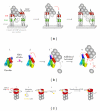Actin dynamics associated with focal adhesions
- PMID: 22505938
- PMCID: PMC3312244
- DOI: 10.1155/2012/941292
Actin dynamics associated with focal adhesions
Abstract
Cell-matrix adhesion plays a major role during cell migration. Proteins from adhesion structures connect the extracellular matrix to the actin cytoskeleton, allowing the growing actin network to push the plasma membrane and the contractile cables (stress fibers) to pull the cell body. Force transmission to the extracellular matrix depends on several parameters including the regulation of actin dynamics in adhesion structures, the contractility of stress fibers, and the mechanosensitive response of adhesion structures. Here we highlight recent findings on the molecular mechanisms by which actin assembly is regulated in adhesion structures and the molecular basis of the mechanosensitivity of focal adhesions.
Figures



Similar articles
-
Actin machinery and mechanosensitivity in invadopodia, podosomes and focal adhesions.J Cell Sci. 2009 Sep 1;122(Pt 17):3037-49. doi: 10.1242/jcs.052704. J Cell Sci. 2009. PMID: 19692590 Free PMC article. Review.
-
Stressing the limits of focal adhesion mechanosensitivity.Curr Opin Cell Biol. 2014 Oct;30:68-73. doi: 10.1016/j.ceb.2014.06.003. Epub 2014 Jul 5. Curr Opin Cell Biol. 2014. PMID: 24998185 Free PMC article. Review.
-
Generation of contractile actomyosin bundles depends on mechanosensitive actin filament assembly and disassembly.Elife. 2015 Dec 10;4:e06126. doi: 10.7554/eLife.06126. Elife. 2015. PMID: 26652273 Free PMC article.
-
Force-induced adsorption and anisotropic growth of focal adhesions.Biophys J. 2006 May 15;90(10):3469-84. doi: 10.1529/biophysj.105.074377. Epub 2006 Mar 2. Biophys J. 2006. PMID: 16513789 Free PMC article.
-
Early molecular events in the assembly of the focal adhesion-stress fiber complex during fibroblast spreading.Cell Motil Cytoskeleton. 2004 Jul;58(3):143-59. doi: 10.1002/cm.20005. Cell Motil Cytoskeleton. 2004. PMID: 15146534
Cited by
-
RhoA activation promotes glucose uptake to elevate proliferation in MAPK inhibitor resistant melanoma cells.bioRxiv [Preprint]. 2024 Jan 11:2024.01.09.574940. doi: 10.1101/2024.01.09.574940. bioRxiv. 2024. PMID: 38260449 Free PMC article. Preprint.
-
Dynamic compartmentalization of purine nucleotide metabolic enzymes at leading edge in highly motile renal cell carcinoma.Biochem Biophys Res Commun. 2019 Aug 13;516(1):50-56. doi: 10.1016/j.bbrc.2019.05.190. Epub 2019 Jun 10. Biochem Biophys Res Commun. 2019. PMID: 31196624 Free PMC article.
-
Promotion of Melanoma Cell Proliferation by Cyclic Straining through Regulatory Morphogenesis.Int J Mol Sci. 2022 Oct 6;23(19):11884. doi: 10.3390/ijms231911884. Int J Mol Sci. 2022. PMID: 36233186 Free PMC article.
-
A Focal Adhesion Filament Cross-correlation Kit for fast, automated segmentation and correlation of focal adhesions and actin stress fibers in cells.PLoS One. 2021 Sep 10;16(9):e0250749. doi: 10.1371/journal.pone.0250749. eCollection 2021. PLoS One. 2021. PMID: 34506490 Free PMC article.
-
The Arp2/3 complex is crucial for colonisation of the mouse skin by melanoblasts.Development. 2020 Nov 15;147(22):dev194555. doi: 10.1242/dev.194555. Development. 2020. PMID: 33028610 Free PMC article.
References
-
- Wang W, Goswami S, Sahai E, Wyckoff JB, Segall JE, Condeelis JS. Tumor cells caught in the act of invading: their strategy for enhanced cell motility. Trends in Cell Biology. 2005;15(3):138–145. - PubMed
-
- Ridley AJ, Schwartz MA, Burridge K, et al. Cell migration: integrating signals from front to back. Science. 2003;302(5651):1704–1709. - PubMed
-
- Le Clainche C, Carlier MF. Regulation of actin assembly associated with protrusion and adhesion in cell migration. Physiological Reviews. 2008;88(2):489–513. - PubMed
-
- Critchley DR. Biochemical and structural properties of the integrin-associated cytoskeletal protein talin. Annual Review of Biophysics. 2009;38(1):235–254. - PubMed
-
- Zaidel-Bar R, Ballestrem C, Kam Z, Geiger B. Early molecular events in the assembly of matrix adhesions at the leading edge of migrating cells. Journal of Cell Science. 2003;116, part 22:4605–4613. - PubMed
LinkOut - more resources
Full Text Sources
Miscellaneous

